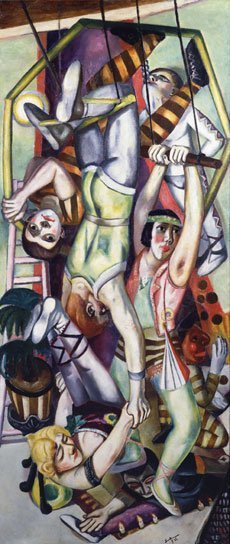Metropolis
The thriving, sophisticated and cosmopolitan metropolis provided a rich source of imagery for artists. By the 1920s, Berlin had become the cultural and entertainment capital of the world and mass culture played an important role in distracting a society traumatised by World War I. The metropolis also came to represent unprecedented personal and sexual freedom and tolerance, and artists depicted scenes of leisure, entertainment and the city at night. George Grosz and Rudolf Schlichter portrayed Berlin’s seedy underbelly. Their brilliant yet sinister representations of brothels and sex murders seem shocking, but their intention was for art to affect social change by representing the victimisation of society’s outcasts. In Frankfurt am Main, Max Beckmann depicted elaborate scenes of outsiders, such as circus and carnival performers, which became metaphors for modern city life and its social corruption.
In photography, modernity was emphasised either by unusual views of the metropolis or through the representation of city types. Contemporary debates around the question of whether a photograph could capture the psychological depth of a person were played out in the works of August Sander and Hugo Erfurth, who photographed many of the most prominent members of German society. The diverse group of works in this room portrays the uninhibited sense of freedom and innovation experienced by artists throughout Germany during the 1920s.

Max Beckmann The trapeze 1923, Toledo Museum of Art, purchased with funds from the Libbey Endowment, gift of Edward Drummond Libbey © Max Beckmann / VG Bild-Kunst, Bonn. Licensed by Viscopy, Sydney. Photo: Photography Incorporated, Toledo